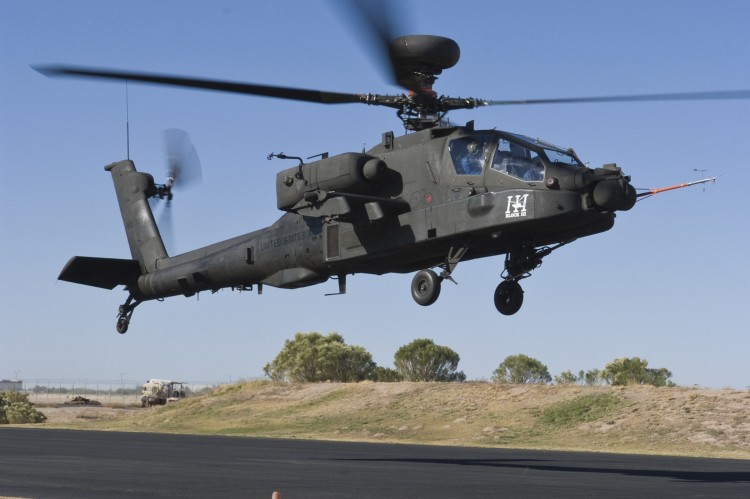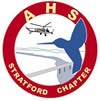The US Army issued an Advanced Attack Helicopter (AAH) Request For Proposals in November 1972 and in December 1976 named the Hughes Model 77 or YAH-64 the winner of the AAH competition. Hughes Helicopters, subsequently McDonnell Douglas Helicopters and today Boeing Vertical Lift produced AH-64A Apaches from 1984 to 1994. The heavily armed, ballistically tolerant, day/night attack helicopter became operational with US Army units in 1986 and saw its first combat deployment in Panama in 1989. By mid-1994, the US Army had over 700 AH-64As in 35 active duty and National Guard battalions based in the continental United States, Germany, and the Republic of Korea. By the end of AH-64A production, the basic Apache had also been delivered to Israel, Saudi Arabia, Egypt, the United Arab Emirates, and Greece.
Apache improvement studies began even before the AH-64A entered full-rate production, and the Army awarded a contract to McDonnell Douglas in 1988 to start an Apache Multi-Stage Improvement Program (MSIP). The AH-64A with General Electric T700-GE-701 engines, Martin Marietta (now Lockheed Martin) Target Acquisition and Designation Sight and Pilot Night Vision Sensor (TADS/PNVS), and AGM-114 Hellfire laser-designated missiles proved notably effective against Iraqi forces in Operation Desert Storm in 1991. The notional AH-64B with navigation and connectivity enhancements was outpaced by technical advances, but AH-64A+ production enhancements included -701C engines, wire strike protection, more electromagnetic hardening, and RAM (Reliability, Availability, Maintainability) improvements.
AH-64D Block I Apache Longbow modernization gave the attack helicopter a Northrop Grumman mast-mounted millimeter wave fire control radar able to distinguish tracked, wheeled, air defense, and airborne targets at long-range and in adverse weather. (The AH-64C designation for aircraft without radar was abandoned in 1994.) The Block I AH-64D fielded in 1997 also integrated “glass cockpits” with tactical displays, an Improved Data Modem, and over-the-horizon radios. The first Apache Longbow multi-year production contact rebuilt 284 AH-64As as Block I AH-64Ds for the U.S. Army. The UK Army acquired 69 similar WAH-64s built by Westland with Rolls Royce RTM322 engines.
Block II AH-64Ds introduced color cockpit displays and T700-GE-701D engines with more power and greater durability. Block II also introduced improved mission display processors and a new optical fiber channel bus 1,000 times faster than the MILSTD 1553B databus in the original Apache. A digital map, HF radio, and an upgraded Improved Data Modem compatible with Joint Variable Message Formats connect the attack helicopter with more air and ground platforms. Later Block II helicopters introduced an open-systems avionics architecture readily upgraded with new hardware and software. Separate from the Block II enhancements, the Apache received the Lockheed Martin Modernized Target Acquisition/Designation Sight and Pilot Night Vision Sensor (M-TADS/M-PNVS) with longer-range, higher-resolution sensors. Block II Apaches transmitted M-TADS imagery to ground tactical operations centers.
The Singapore Armed Forces (SAF) received their first new-build Apache Longbow in May 2002. The Japan Self Defense Forces took delivery of their first AH-64D from Fuji Heavy Industries in 2006. Boeing subsequently built new Block II AH-64D Wartime Replacement Aircraft for the U.S. Army and converted more AH-64As to D-models for existing international Apache operators.
The US Army receives its last Block II AH-64D Apache Longbows in September 2013 with the last three AH-64A-to-D conversions and a new-build War Replacement Aircraft. Block III AH-64E Guardian modernization further enhances Apache lethality and recovers AH-64A performance. The latest helicopter consequently integrates high-lift composite main rotor blades with T700-GE-701D engines and an efficient split-torque face gear transmission. An Open System avionics architecture simultaneously expands Apache digital connectivity and gives the attack helicopter crew Level IV control over Unmanned Aircraft Systems. Block II Apache Longbows with VUIT-2 (Video Unmanned aerial system Intelligence Teaming) have Level 2 UAS control to see UAS imagery. Block III helicopters can re-route the Gray Eagle UAS in flight and steer the UAS sensors.
The AH-64E completed Initial Operational Test and Evaluation in April 2012 and has received a full rate production approval. The First Unit Equipped with the AH-64E stands up in May 2013, and Initial Operation Capability is scheduled for November of this year. The US Army’s acquisition objective is 690 Apache Block III aircraft. First Foreign Military Sales customers for the AH-64E are reportedly Taiwan and Indonesia or Qatar. Eleven countries now operate AH-64D Apache Longbows and are candidates for Block III modernization.

